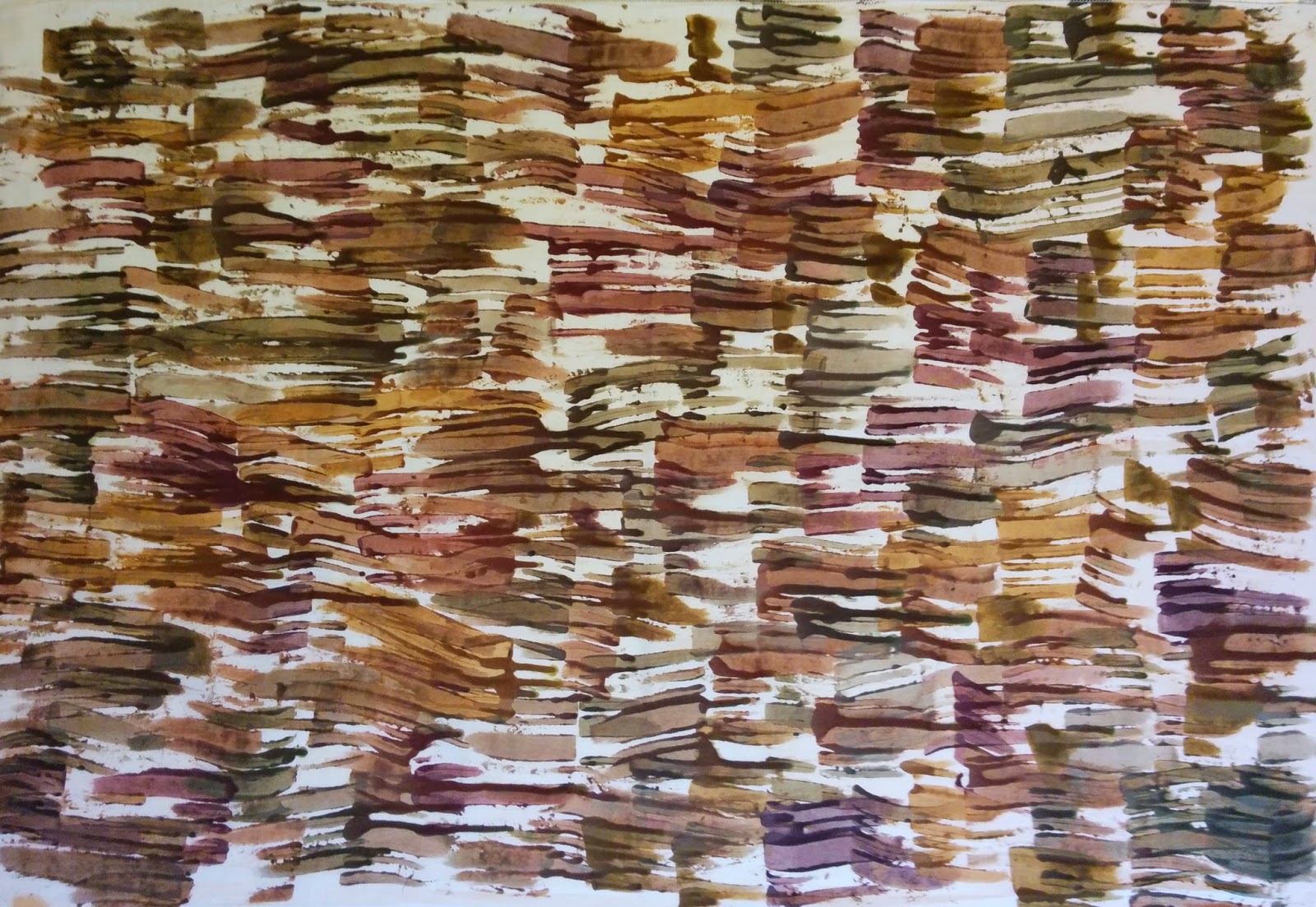Neutral Territories is all about finding the blacks, greys and browns hiding in various combinations of MX reactions dyes. In
Carol Soderlund's workshop at
ProChemical & Dye, we were not handed individual recipes to dye neutral colors. Instead, we were taught how to search systematically for neutral colors. I was delighted to expanded my grasp of color through this process. Toss in some discharge and thickened dye exercises and it was dye heaven!
Here is one sample card from my notebook - all of the colors are closely related.. The row on top was my favorite neutral grey/black. Some seemingly black colors on the right hand column when lightened are shown to have blue, purple and reddish shades. The lightest values on the left hand column become more similar as the dye is diluted.
Below is the sample card that I dyed in my search for browns given the dyes used for the grant: tangerine, strongest red and deep navy. I found the range of browns very pleasing. Carol's exercises taught me to evaluate the samples. I know that I'd like to explore browns with slightly less red and more yellow hue based on the colors below. Additionally, I'll be breaking down these browns into value gradations (like the picture above) to understand them better and increase my color vocabulary.
The workshop included time for individual projects. I noticed a fellow student, Laura, had put notches in an old credit card and was scraping with thickened dyes. I decided to follow suit using the nine closely related brown dyes from above. Our marks looked totally different. Here is the credit card and the two pieces created using my freebie tool:
I still had dye left, so I did some stamping with a 16oz plastic cup, a plastic salsa cup, a wooden thread spool and a plastic core from Mettler thread. I was thinking about
Christopher Alexander's
Property of Wholeness "
Levels of Scale" when I chose my circles in 4 sizes. The dye was applied thickly in places, so it dripped when I hung it up out of the way. I'm going to think of this as a two techniques bonus...stamping and dripping.

Messy plastic cups and dedicated brushes filled with a residue of thickened dye sat in front of me, but what to do with it? I decided to add a bit of water and create dye washes to help clean up the brushes and cups. Thickened dyes are *NOT* good for your drains! It was a neat exercise in seeing how far the dye would go... Once I had the stripes painted on the fabric, it occurred to me that I hadn't added soda ash anywhere along the line...ooops! I scrunched up the fabric lengthwise and rolled it up like a cinnamon roll. I stuffed it into a tight container (could't find a looser fit) and added some soda ash water. I squirted some black dye on top of the fabric roll for good measure. The error prompted me to create a piece more interesting than the original plan. I love getting 2 visual layers for one dye process.

The last piece was created to use up the dregs of the dye washes. I poured the remaining brown and black dyes into the bottom of a container and mopped it up with fabric that I had scrunched in my hand. I rescrunched (it's a technical term despite what spell check is telling me...really...) the fabric in the container. I squirted some leftover black dye on top and left it to batch. Now I have a variety of related fabrics and very little wasted dye.
 |
| Scrunched fabric with colors breaking from a custom mixed black and browns. |
 |
| Detail from the scrunched fabric above. |
Dye companies such as ProChemical & Dye and Dharma Trading offer a few premixed browns, blacks and greys, but there are so many more available for the adventurous dyer! Using the primary and secondary pure colors with neutrals blended from those dyes allow all of the colors used in a piece to harmonize. Bright colors pop thanks to neutral colors. The Neutral Territories workshop was inspiring. It was my fourth color/dyeing class taken from Carol Soderlund. She continues to offer new insights into color and dyeing. I highly recommend her classes. You'll find them well run, fun and chock full of information with excellent notes and samples to take home.















